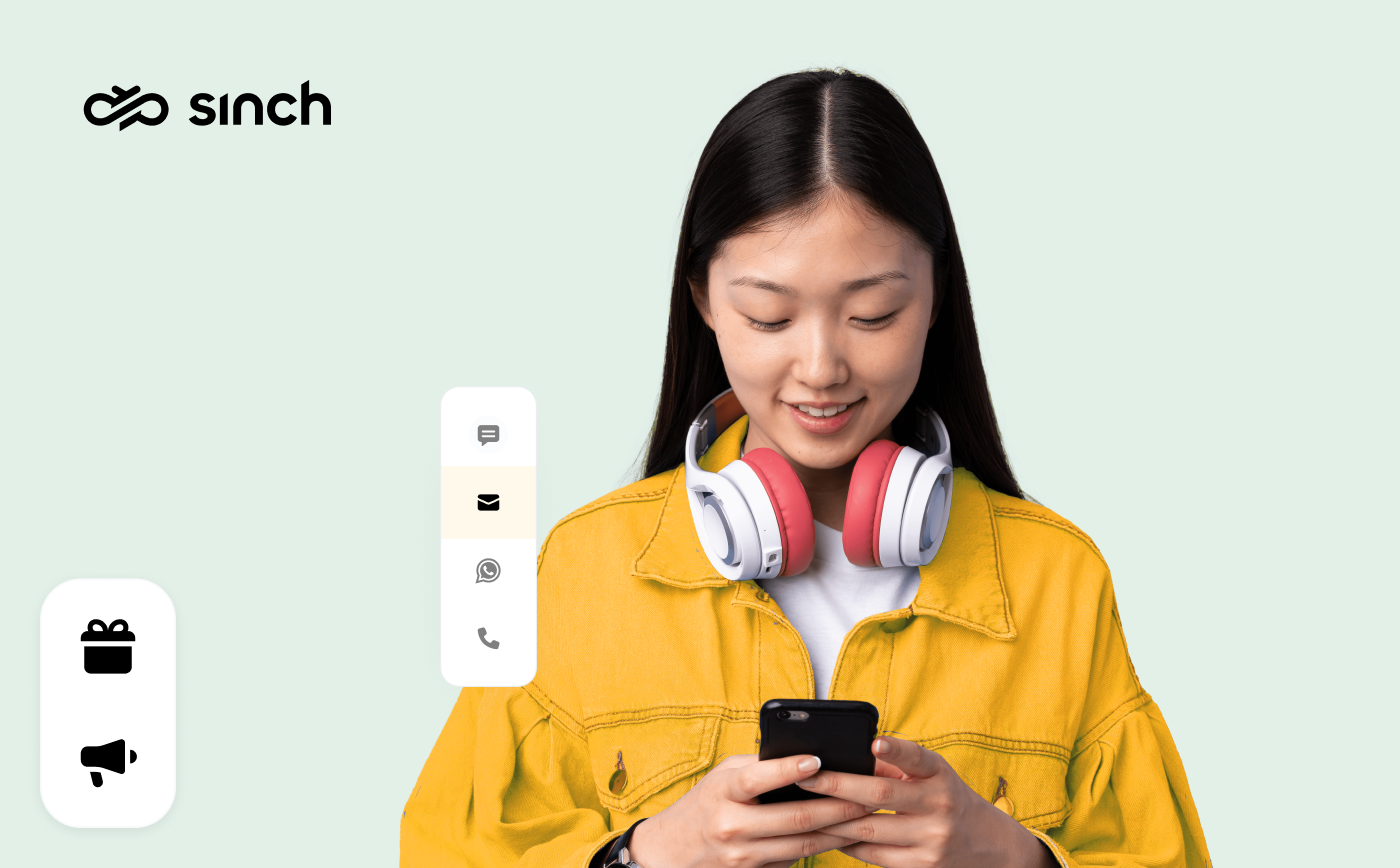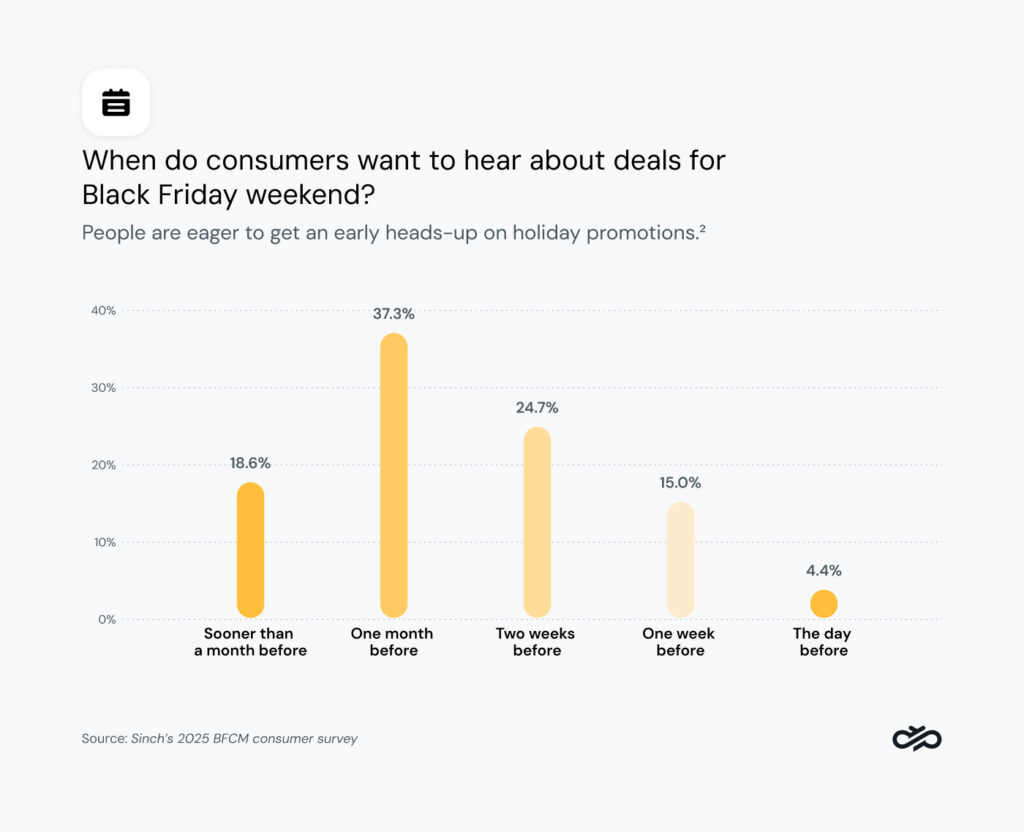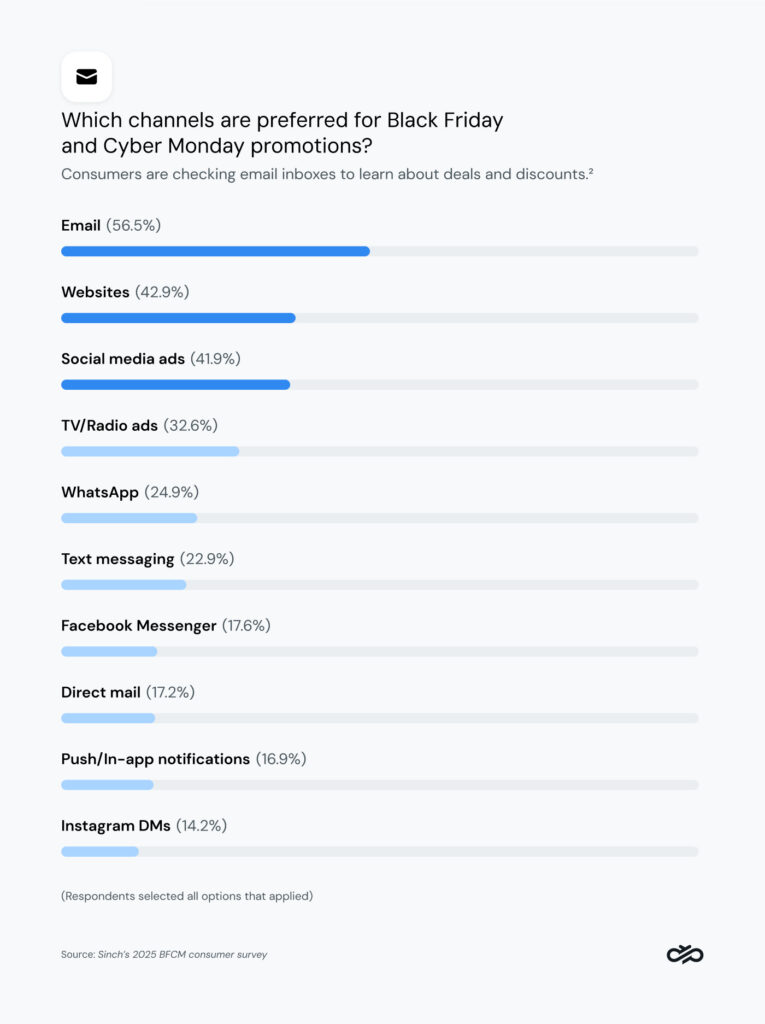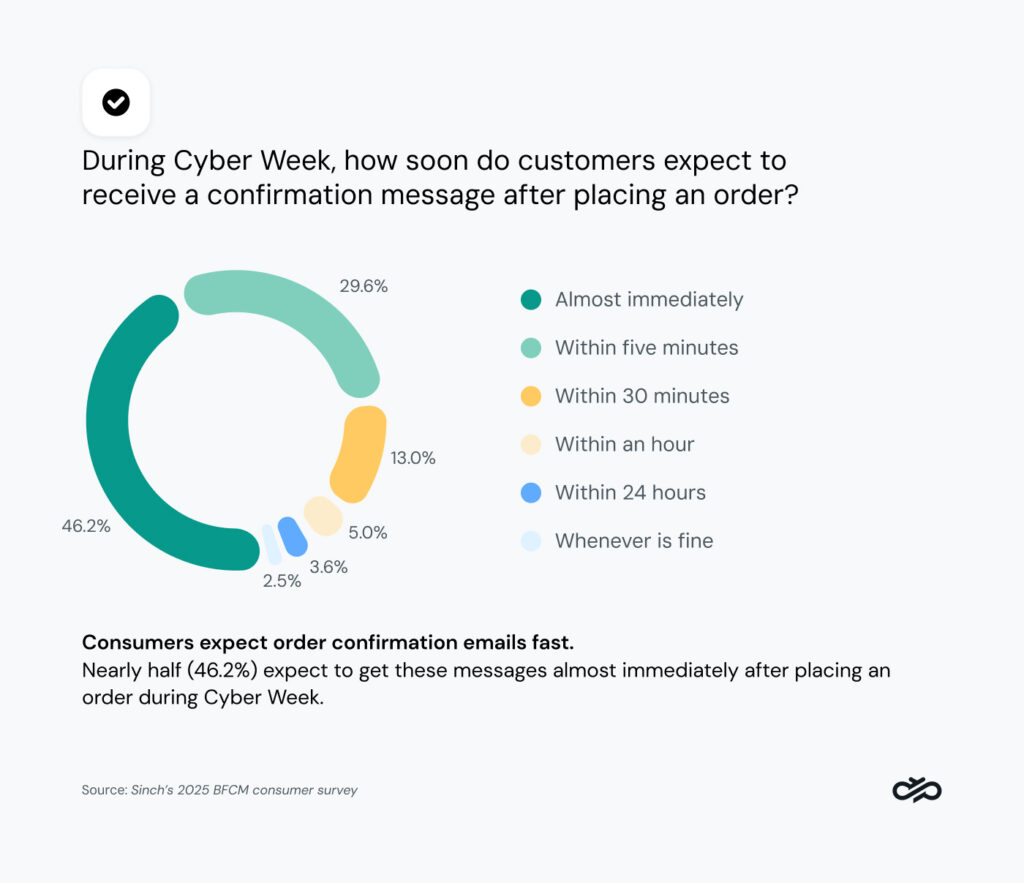Campaigns, Insights
How to build a better, more personal omnichannel strategy for BFCM 2025

Campaigns, Insights

Black Friday and Cyber Monday (BFCM) 2025 are shaping up to be more complex than ever. Shoppers know what they want and expect brands to deliver experiences that feel personal and connected.
The old approach of sending promotional messages everywhere no longer gets the job done. Now it’s about showing up in the places where your customers spend their time with messages that are timely, relevant, and helpful.
According to Sinch’s 2025 BFCM consumer survey, 71.7% of consumers want brands to communicate across multiple channels this year. That number dropped from 78.5% last year. This decline signals a crucial shift from quantity to quality in customer communications.
Shoppers now prioritize meaningful interactions over constant contact. They expect brands to show up with the right message, at the right time, on the right channel.
The insights ahead come from extensive research, including Sinch’s 2025 BFCM consumer survey and The state of customer communications report. Let’s explore how to build an omnichannel strategy that delivers what your customers want this BFCM season.
Omnichannel marketing isn’t what it used to be, and a lot of that has to do with the fact that today’s shoppers move fluidly between channels, comparing prices via email, researching via mobile, and discovering new products on social media. They expect brands to match their precision.
According to our 2025 BFCM consumer survey, 72.7% of consumers still value personalized offers, yet 16.9% now say personalization feels invasive. That tension defines the new omnichannel reality.
of consumers still value personalized offers around BFCM
of 2025 consumers say personalization feels invasive
Just how ecommerce brands must balance personalization with privacy, marketers must respect consumer boundaries while still delivering relevance. The key lies in giving consumers control over their communication preferences. The state of customer communications found that 58% of consumers want to choose their preferred channel when they opt in to communications. They expect flexibility within boundaries they set themselves.
The rise of AI adds another layer to this evolution. While 49.3% of consumers trust AI’s recommendations as much as (or more than) those from humans, 43.6% remain concerned about privacy and data use.
Efficient brands will blend automation with empathy. Instead of hitting customers with messages on every platform, they’ll use email marketing when consumers are researching products, SMS marketing for time-sensitive deals and discount codes, and social media when they’re looking for inspiration.
“Omnichannel” during BFCM 2025 doesn’t mean using all channels – it means using the optimal channel to make every interaction feel intentional.
Getting the timing right and building real trust with shoppers will determine which brands win and which lose this BFCM.
Our research shows that 37.3% of consumers expect promotions a full month before Black Friday. That early demand has reshaped how retailers plan campaigns. Many online stores and direct-to-consumer brands now launch their BFCM campaigns weeks in advance to capture first-time buyers and build momentum.

Beyond timing, trust is now the deciding factor in whether consumers open, click, and convert. Trust comes from being transparent in every message you send. Modern messaging channels like WhatsApp and RCS have verified sender profiles so customers know exactly who they’re hearing from. This verification builds trust and gives shoppers the confidence they need before clicking through or making a purchase.
Consumers are also signaling they want reliability across multiple channels for important updates:
Retailers who succeed understand that sending quality messages on the right channels is better than using every possible channel. Each message needs to add value while respecting customer preferences and communication boundaries. Focus on conversion rates and profitability rather than just sending more messages.
Choosing the right channel for each stage of your customer’s journey makes all the difference between a smooth purchase and a frustrating dead end.
Unlike multichannel strategies that keep each platform in its own silo, omnichannel strategies connect every interaction. Our research pinpoints which channels drive the best results at each stage of the BFCM customer journey.
Email remains the dominant channel for holiday deal announcements, with 56.5% of consumers choosing it as their preferred method for hearing about BFCM promotions. This preference holds steady across demographics, though generation-specific patterns emerge in secondary channel choices.

Different generations have different expectations when it comes to the awareness stage:
Of course, these findings could vary widely within your own customer base, and success will depend on what you know and learn about your audience. Email can stay the foundation, and then you can also layer on other channels that your customers prefer.
During the consideration and purchase phases, relevance becomes everything. Around one third of consumers find irrelevant promotional messages frustrating, making targeted communication essential for keeping shoppers engaged rather than annoyed.
The key lies in personalization that helps people rather than scares them away.
Useful personalization might include sending cart abandonment reminders with the specific items left behind, product recommendations based on browsing history, or personalized discount codes for subscribers based on their average order value (AOV).
Invasive personalization crosses the line when messages reference too much personal information or make assumptions about lifestyle and income.
SMS and messaging apps can excel during these critical stages. Quick order confirmations, shipping updates, and time-sensitive offers perform best through instant channels. Email works for detailed product comparisons and reviews, while retargeting campaigns can bring hesitant shoppers back to complete their purchase.
Give shoppers the information they need exactly when they need it, using the channel they check most often during their decision-making process.
Post-purchase communication needs to be quick and reliable above all else. A staggering 93% of shoppers consider confirmation and shipping updates essential during the holiday season, and most expect those messages to arrive within five minutes of purchase.

But post-purchase expectations don’t look the same everywhere. Channel preferences vary significantly by region, reflecting different digital cultures and regulations. WhatsApp dominates in India, Brazil, and Mexico, while its importance continues to grow in the U.S. market. European customers often prefer SMS for transactional updates. Asian markets show strong preferences for messaging apps like LINE and WeChat.
For brands selling globally, that diversity brings both opportunity and complexity. You have to both be present on the right channels and also know which channels your customers actually trust. The brands that get this right work with local experts and partners who understand regional preferences, privacy requirements, and compliance standards.
A diverse mix of channels will help you win, too, like a quick confirmation through a preferred messaging app, a detailed receipt by email they can save, and real-time shipping updates by text or phone notification. It’s good to have all the options available while giving your customers the ability to choose how they want to hear from you. Being flexible ensures customers stay informed without feeling overwhelmed, especially during the hectic holiday season.
Customer service during BFCM faces unprecedented volume spikes that can overwhelm even the most prepared customer support teams. Chatbots can help manage this peak demand, with 53% of shoppers open to using automated assistance for order tracking and 37.9% comfortable with after-hours bot support.
These acceptance rates reveal an opportunity to handle routine inquiries efficiently while freeing human agents for complex issues. Chatbots excel at instant order status updates, return policy questions, and basic product information. They provide 24/7 availability when customers shop outside traditional business hours or across time zones.
Use chatbots for simple questions and routine requests, then hand off complicated issues to real people. This keeps wait times short during the holiday rush while making sure customers with tricky problems get the personal help they need. Just be upfront about whether they’re talking to a bot or a person – transparency prevents unsubscribes and maintains customer trust.
There’s no one-size-fits-all channel mix for BFCM success. Your optimal combination depends on understanding your specific audience demographics, shopping behaviors, and regional preferences. Test different channel combinations before the holiday rush hits, see what works, and adjust based on your own results.
Make sure support conversations flow smoothly across channels to deliver a strong post-purchase experience.
Conversational commerce turns one-way marketing into actual conversations. Customers can ask questions, get help, and buy products directly in a chat without jumping to a different website or app.
The shift has already happened behind the scenes. A remarkable 96% of retail leaders say they’re using conversational commerce for two-way customer communications. Shoppers are catching on too, with nearly half saying AI makes their shopping easier.
What makes conversational commerce work during BFCM? Speed and context.
Customers can ask questions, get recommendations, and complete purchases without leaving their messaging app. AI handles simple queries instantly while remembering previous interactions.
When combined with human agents for complex issues, this creates shopping experiences that feel more like chatting with a knowledgeable friend than navigating a website alone.
Picture Amanda, a busy parent shopping for BFCM deals. Three weeks before Black Friday, she gets an email preview of upcoming sales from her favorite electronics retailer. She clicks through, browses a few items, then closes the tab when life gets busy.
The next day, she gets an SMS reminder about the items she viewed, with a 10% early-bird discount. She adds a tablet to her cart via the SMS link but doesn’t complete the purchase.
A few hours later, a WhatsApp message arrives from the retailer’s verified business account with her saved cart and a quick video highlighting the tablet’s kid-friendly features. Amanda asks a chatbot about warranty options and receives and instant, clear answer. She completes her purchase right in WhatsApp.
Minutes later, she receives:
When she has a question about delivery timing, she messages the retailer on WhatsApp and gets connected to a human agent who can see her full purchase history. Post-BFCM, she receives a thank-you email with recommendations for accessories and an invitation to join the loyalty program for future holiday sales.
This is what an omnichannel strategy looks like in action: connected, consistent, and customer-led. Behind the scenes, Sinch ties all channels together, so messages reach customers and follow local rules. It handles the technical heavy lifting of linking everything together and making sure messages get delivered, so brands can focus on creating great shopping experiences during BFCM.
Put these strategies into practice now to prepare for the holiday shopping season.
A BFCM strategy is your plan for maximizing sales during Black Friday and Cyber Monday, the biggest shopping days of the year. It covers everything from when to start promotions (typically three to four weeks early), which channels to use for different messages, how to handle increased customer service volume, and what technology you’ll need to process orders smoothly. The best strategies coordinate marketing, inventory, fulfillment, and customer service to create seamless shopping experiences during peak demand.
The most effective BFCM strategy starts early with exclusive previews for loyal customers, then builds momentum through targeted messaging on each customer’s preferred channel. Focus on creating genuine value rather than just offering discounts. Share gift guides, bundle deals, and limited-time offers that solve specific shopping needs. Use verified messaging channels like RCS and WhatsApp to cut through inbox clutter. Most importantly, make purchasing simple with one-click buying options and clear inventory updates. Consider how countdown timers and limited stock notifications can create urgency without sacrificing the user experience.
Segment your customers based on their shopping behavior and communication preferences rather than just demographics. Group them by:
Create specific messaging for each segment. VIP customers might get early access, while cart abandoners receive personalized reminders. This targeted approach increases relevance and reduces the frustration of irrelevant messages. Track which segments drive the highest order value and adjust your BFCM campaigns accordingly to maximize both acquisition of first-time customers and retention of existing ones.
Small businesses can compete by focusing on personal service and unique value rather than trying to match big retailers’ discounts. Start promotions early when customers have more time to discover smaller brands. Use cost-effective channels like SMS marketing and email campaigns for direct communication. Tools like Sinch Engage make this simple – combining SMS, WhatsApp, and email in one easy platform so you can reach customers on their preferred channels without extra setup or technical effort. Create exclusive bundles or limited-edition items that customers can’t find elsewhere. Use your ability to provide genuine human interaction through conversational commerce. Most importantly, ensure your website and fulfillment can handle increased traffic to avoid disappointing eager customers.
Success this BFCM isn’t about maxing out your marketing budget across a dozen platforms.
Start by asking your customers how they want to hear from you, then design every touchpoint around those choices. Send deal announcements by email, deliver order updates via text, and handle questions through chat. Cut the channels that aren’t working – your customers will appreciate fewer, better messages over constant noise.
This BFCM, remember that omnichannel doesn’t mean more messages, but means more meaningful ones. The brands that understand that difference will stand out this Black Friday and Cyber Monday.
For more data on customer preferences, channel performance, and regional differences around the year, read Sinch’s full State of customer communications report.